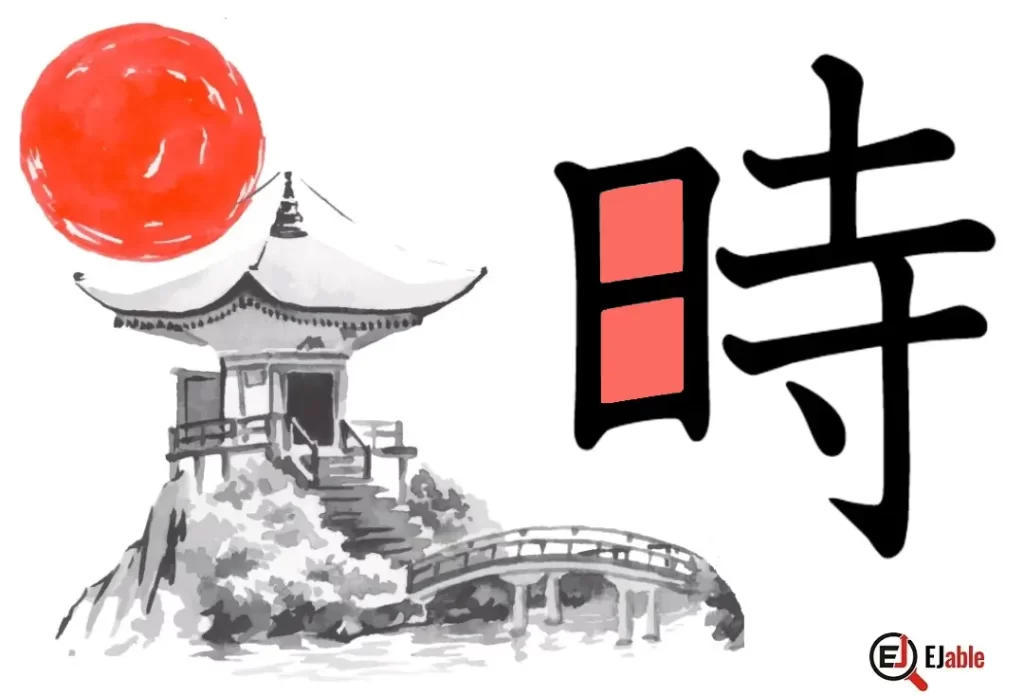Kanji for Time: 時 (Toki / Ji)

The Japanese kanji for “Time” is 時.
The pronunciation of the Kanji 時 is “Toki” (とき) in its kun’yomi (Japanese reading) and “ji” (ジ) in its on’yomi (Chinese reading).
In some contexts, 時 can also refer to an occasion, moment, or period, as in その時 (そのとき / sono toki), meaning “at that time” or “then.”
Please note that when writing time, the Kanji 時 denotes the hour. Minutes and seconds are written as 分 and 秒 respectively. For example, 9 時 10 分 50 秒 in the morning means 10 minutes 50 seconds past 9 a.m.
Construction and Origin of the Kanji 時
The Kanji 時, meaning “time,” is constructed with 10 strokes. This Kanji is a part of the JLPT N5 syllabus (please check the list of JLPT N5 Kanji). In Japanese schools, this Kanji is taught in grade 2.
The shape of time’s kanji 時 originated from a combination of two elements. The left side part is the component 日, which means “sun” and also “day.” The component on the right-hand side is 寺, the kanji for the temple.
The component representing the temple is also used phonetically for its sound “ji” for the pronunciation of the kanji for time.
The concept of time (時) in this Kanji is thought to be derived from the ancient temples’ involvement with the observatories in those days to track the sun’s movement for the measurement of time.
In ancient times, the movement of the sun was the most obvious and reliable indicator of time. The position of the sun in the sky was used to determine different times of the day. This connection to the sun is crucial in understanding the Kanji’s relationship with the concept of time.
In many ancient cultures, including those in East Asia, temples played an important role in astronomical observations and timekeeping. They often served as centers for tracking celestial movements, including the sun, to maintain calendars and mark important seasonal events.
With a central role in society, ancient temples were the rare public structures where the knowledge of science and technology could be experimented, applied, and demonstrated. Check this article on Louisiana State University’s website.
Mnemonic: How to Remember the Kanji of Time (時)

There are two prerequisites to remembering time’s kanji quickly:
- The connection of the sun (日) with time and how time measurement started with the changing phases of the days and seasons.
- To Know the Kanji for “Temple” 寺.
Once you remember the above two points, it will become very logical to associate the Kanji 時 with “time”.
Time (時) in Compounded Japanese Words
The kanji for “time” 時 (“toki,” とき) or (“ji,” ジ), is commonly used in the Japanese language and forms part of many compound words. There are 265 Japanese words that begin with the Kanji 時, and it appears in 954 words.
Examples of Kanji 時 in Compounded Kanji Characters
Following are the examples where Kanji for time appears in Japanese compounded Kanji characters:
- 時間 (じかん / jikan): Time, period of time.
- 時代 (じだい / jidai): Era, age.
- 時刻 (じこく / jikoku): Moment, specific time.
- 定時 (ていじ / teiji): Fixed time, regular time.
- 一時 (いちじ / ichiji): 1 o’clock, for a time, once, at one time, formerly
- 時速 (じそく / jisoku): Speed per hour.
- 同時 (どうじ / dōji): Simultaneous, at the same time.
- 時差 (じさ / jisa): Time difference.
- 時々 (ときどき / tokidoki): Sometimes, from time to time.
- 時期 (じき / jiki): Season, period.
- 時計 (とけい / tokei): Clock, watch.
- 時刻表 (じこくひょう / jikokuhyō): Timetable, schedule.
- 時流 (じりゅう / jiryū): Trend, current of the times.
- 時価 (じか / jika): Current price, market price.
- 時給 (じきゅう / jikyū): Hourly wage.
These compound words demonstrate the versatility of 時 in expressing various concepts related to time, such as duration, specific moments, simultaneity, and periodicity in the Japanese language.
Please note that time’s kanji also appears in 4 other kanji characters as a component; however, none of those are Jōyō Kanji, so you can ignore those.
Note: Check other Kanji characters on the page “How to Remember Kanji“. You may also like to read about the common Kanji radicals.

A long-term ex-pat in Japan, Himanshu comes with an IT background in SAP consulting, IT Business Development, and then running the country operations of an IT consulting multinational. Himanshu is the co-founder and Managing Director of ReachExt K.K. and EJable.com. He is also an Advisory Board Member of a Silicon Valley AI/IoT startup.
